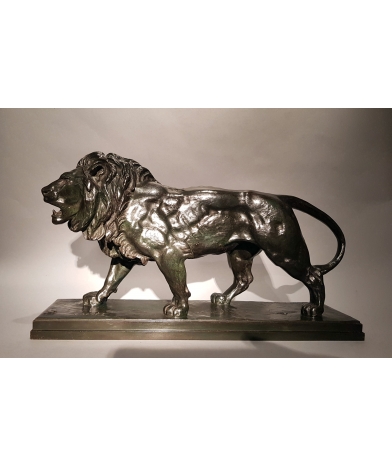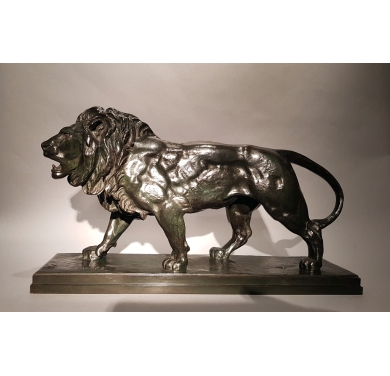Antoine Louis Barye (1795-1875) - The Walking Lion
Cast with brown shaded patina, signed BARYE on the terrace
Dimensions : H. 23 x W. 41 x D. 10 cm
Antoine Louis Barye was born in Paris in 1795.
He is one of the great masters of Romantic sculpture along with David d'Angers and Rude.The theme that largely dominates his work is animal sculpture. He remains the first and greatest animal artist of the 19th century.
He was the son of Pierre Barye, a silversmith from Lyon who moved to Paris after the troubles of 1793.
At the age of fourteen he was placed as an apprentice with Fourier, a metal engraver who supplied accessories for military clothing and also worked for the famous goldsmith Biennais.
In 1816, he entered the workshop of the sculptor Bosio, then in 1817 that of the painter Gros and in 1818 at the Ecole des Beaux-Arts. From 1823 to 1831 he worked with Fauconnier, who enabled him to familiarise himself with the trade of foundryman and chiseller, which he later practised on his own account.
Barye studied the animals themselves from nature, in particular the wild animals whose power, restrained form and suppleness captivated him.
After his death in 1875, most of his plaster casts and models were bought by Ferdinand Barbedienne, the famous metallurgist and best foundryman of the time. Barbedienne continued to cast bronzes from Barye's original models. All these casts are marked F. Barbedienne. The casts were made with extreme attention to detail and continued Barye's keen interest in multicoloured patinas. Today, most of Barye's original plaster casts and models are owned by the Louvre.
Museums:
Paris, Louvre Museum; Musée d'Orsay; Petit Palais and Musée des Arts Décoratifs





